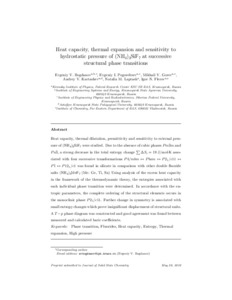Heat capacity, thermal expansion and sensitivity to hydrostatic pressure of at successive structural phase transitions
Скачать файл:
URI (для ссылок/цитирований):
https://www.sciencedirect.com/science/article/pii/S0022459619302063?via%3Dihubhttps://elib.sfu-kras.ru/handle/2311/129695
Автор:
Evgeniy V.Bogdanov
Evgeniy I. Pogoreltsev
Mikhail V. Gorev
Andrey V. Kartashev
Natalia M. Laptash
Igor N. Flerov
Коллективный автор:
Институт инженерной физики и радиоэлектроники
Кафедра теплофизики
Дата:
2019-08Журнал:
Journal of Solid State ChemistryКвартиль журнала в Scopus:
Q2Квартиль журнала в Web of Science:
Q2Библиографическое описание:
Evgeniy V.Bogdanov. Heat capacity, thermal expansion and sensitivity to hydrostatic pressure of at successive structural phase transitions [Текст] / Evgeniy V.Bogdanov, Evgeniy I. Pogoreltsev, Mikhail V. Gorev, Andrey V. Kartashev, Natalia M. Laptash, Igor N. Flerov // Journal of Solid State Chemistry. — 2019. — Т. 276. — С. 152-158Аннотация:
Heat capacity, thermal dilatation, permittivity and sensitivity to external pressure of (NH4)3SiF7 were studied. Due to the absence of cubic phases Pm¯ 3m and Pa¯3, a strong decrease in the total entropy changeP∆Si = 19 J/mol·K associated with four successive transformations P4/mbm ↔ Pbam ↔ P21/c11 ↔ P¯ 1 ↔ P121/c1 was found in silicate in comparison with other double fluoride salts (NH4)3MeF7 (Me: Ge, Ti, Sn) Using analysis of the excess heat capacity in the framework of the thermodynamic theory, the entropies associated with
each individual phase transition were determined. In accordance with the en
tropic parameters, the complete ordering of the structural elements occurs in
the monoclinic phase P21/c11. Further change in symmetry is associated with
small entropy changes which prove insignificant displacement of structural units. A T−p phase diagram was constructed and good agreement was found between measured and calculated baric coefficients.

